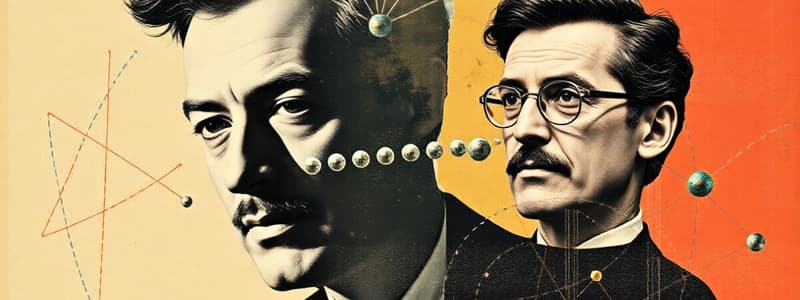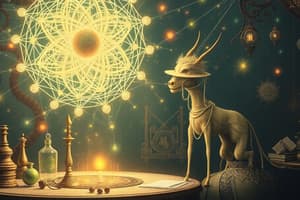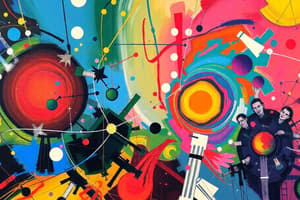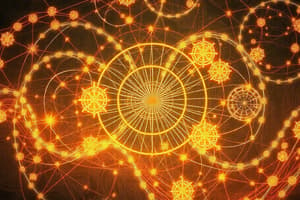Podcast
Questions and Answers
What aspect of quantum theory did Richard Feynman focus on during his career?
What aspect of quantum theory did Richard Feynman focus on during his career?
- Quantum entanglement
- Quantum teleportation
- Quantum electrodynamics (QED) (correct)
- Quantum cryptography
Which milestone did Richard Feynman achieve during his graduate entrance exams at Princeton University?
Which milestone did Richard Feynman achieve during his graduate entrance exams at Princeton University?
- He achieved a perfect score in physics. (correct)
- He received a special award for mathematical theories.
- He was admitted without taking the exams.
- He was the first to complete a PhD in quantum mechanics.
What significant award did Richard Feynman receive in 1965?
What significant award did Richard Feynman receive in 1965?
- Nobel Prize in Physics (correct)
- National Medal of Science
- CERN Medal of Honor
- Albert Einstein Award
Which university did Feynman join as a professor of theoretical physics after his work at Cornell University?
Which university did Feynman join as a professor of theoretical physics after his work at Cornell University?
What was the nature of Feynman's work during the Manhattan Project?
What was the nature of Feynman's work during the Manhattan Project?
What did Feynman's lectures at Caltech lead to in 1964?
What did Feynman's lectures at Caltech lead to in 1964?
What were Feynman's primary concerns that led him to join the Manhattan Project?
What were Feynman's primary concerns that led him to join the Manhattan Project?
What significant contribution did Feynman's work in QED focus on?
What significant contribution did Feynman's work in QED focus on?
What aspect of Feynman diagrams makes them particularly valuable in quantum electrodynamics (QED)?
What aspect of Feynman diagrams makes them particularly valuable in quantum electrodynamics (QED)?
Which of the following statements about Murray Gell-Mann's contributions is correct?
Which of the following statements about Murray Gell-Mann's contributions is correct?
How did Feynman demonstrate the cause of the Challenger disaster?
How did Feynman demonstrate the cause of the Challenger disaster?
What role do Feynman diagrams play in contemporary particle physics?
What role do Feynman diagrams play in contemporary particle physics?
What phenomenon did Feynman explain concerning helium at absolute zero?
What phenomenon did Feynman explain concerning helium at absolute zero?
What significant impact did Feynman's revisions have on quantum electrodynamics (QED)?
What significant impact did Feynman's revisions have on quantum electrodynamics (QED)?
Which group of particles did Gell-Mann categorize as fundamental building blocks of matter?
Which group of particles did Gell-Mann categorize as fundamental building blocks of matter?
What characteristic distinguishes Feynman diagrams in particle physics?
What characteristic distinguishes Feynman diagrams in particle physics?
Which statement best describes the nature of quantum probabilities as utilized in Feynman's work?
Which statement best describes the nature of quantum probabilities as utilized in Feynman's work?
What was one of the unique features of Feynman's lectures at Caltech?
What was one of the unique features of Feynman's lectures at Caltech?
Flashcards
What is quantum electrodynamics (QED)?
What is quantum electrodynamics (QED)?
A quantum theory that explores the interactions of charged particles through the exchange of light packets, or 'quanta,' of energy.
What was Richard Feynman's major contribution to physics?
What was Richard Feynman's major contribution to physics?
Richard Feynman's work on quantum electrodynamics (QED) revolutionized our understanding of how charged particles interact.
What was Feynman's key achievement in QED?
What was Feynman's key achievement in QED?
Feynman's significant work on QED involved resolving mathematical inconsistencies within the theory.
What was Feynman's contribution during World War II?
What was Feynman's contribution during World War II?
Signup and view all the flashcards
When did Feynman show his genius for mathematics?
When did Feynman show his genius for mathematics?
Signup and view all the flashcards
Where was Feynman denied admission initially?
Where was Feynman denied admission initially?
Signup and view all the flashcards
What did Feynman study at MIT initially?
What did Feynman study at MIT initially?
Signup and view all the flashcards
How did Feynman showcase his brilliance on the Princeton entrance exams?
How did Feynman showcase his brilliance on the Princeton entrance exams?
Signup and view all the flashcards
Quantum Electrodynamics (QED)
Quantum Electrodynamics (QED)
Signup and view all the flashcards
Feynman Diagrams
Feynman Diagrams
Signup and view all the flashcards
Standard Model of Particle Physics
Standard Model of Particle Physics
Signup and view all the flashcards
Quarks
Quarks
Signup and view all the flashcards
Bosons
Bosons
Signup and view all the flashcards
Fermions
Fermions
Signup and view all the flashcards
Feynman Diagrams: A visual representation of complex equations
Feynman Diagrams: A visual representation of complex equations
Signup and view all the flashcards
Nanotechnology
Nanotechnology
Signup and view all the flashcards
Superfluidity
Superfluidity
Signup and view all the flashcards
Quantum Computing
Quantum Computing
Signup and view all the flashcards
Study Notes
Richard Feynman: A Physicist's Life
- Born in New York, to Lithuanian Jewish parents, Feynman struggled to speak until age 3 but later excelled in math and gadgets, theorizing math in high school.
- Refused admission to Columbia due to quota, attended MIT, then excelled at Princeton's graduate exams (perfect score).
- Earned PhD in quantum mechanics in 1942.
- Participated in the Manhattan Project due to concerns about Nazi victory.
- Appointed professor of theoretical physics at Cornell in 1945, worked on quantum electrodynamics (QED).
- QED explained electromagnetically charged particle interactions via photon exchange. Early versions had mathematical flaws.
- Feynman formulated a revised QED theory (1948) using Feynman diagrams to visualize electron/photon movements.
- Diagrams were mathematical models showing all event probabilities, simplifying complex equations, and allowing for calculations in particle accelerators like the LHC.
- Feynman diagrams are still used extensively in particle physics.
- Feynman's work significantly advanced QED, becoming a model for other basic force theories..
- Made contributions to other areas like partons (precursor to quarks), nanotechnology, quantum computing, and superfluidity.
- Led a team in 1986 investigating the Challenger Disaster, demonstrating the accident's cause with an experiment using ice water and rubber.
- Published popular lectures as the Feynman Lectures on Physics, a widely used textbook.
- Awarded the Nobel Prize in Physics in 1965 (jointly with others) for his work on QED.
Feynman Diagrams & Explanation
- Feynman diagrams illustrate electron and photon movement in time and space.
- Straight lines depict an electron, and wavy lines represent photon exchange between electrons.
- Despite initially seeming like simple doodles, diagrams represent complex equations.
- The diagrams' simplicity highlights Feynman's ability to explain complex physics concepts accessibly.
Murray Gell-Mann: Particle Classification
- Murray Gell-Mann (1929–), proposed a model in 1964 for classifying subatomic particles.
- This model distinguished between fermions (matter building blocks) and bosons (force carriers).
- His model introduced the hypothetical "quark" as a fundamental unit to explain particle behavior.
- Quarks grouped together formed hadrons (protons and neutrons).
- The quark was later isolated using particle accelerators, confirming the model's validity.
- Gell-Mann was awarded the Nobel Prize in Physics in 1969, establishing the model known as the "standard model".
Studying That Suits You
Use AI to generate personalized quizzes and flashcards to suit your learning preferences.





